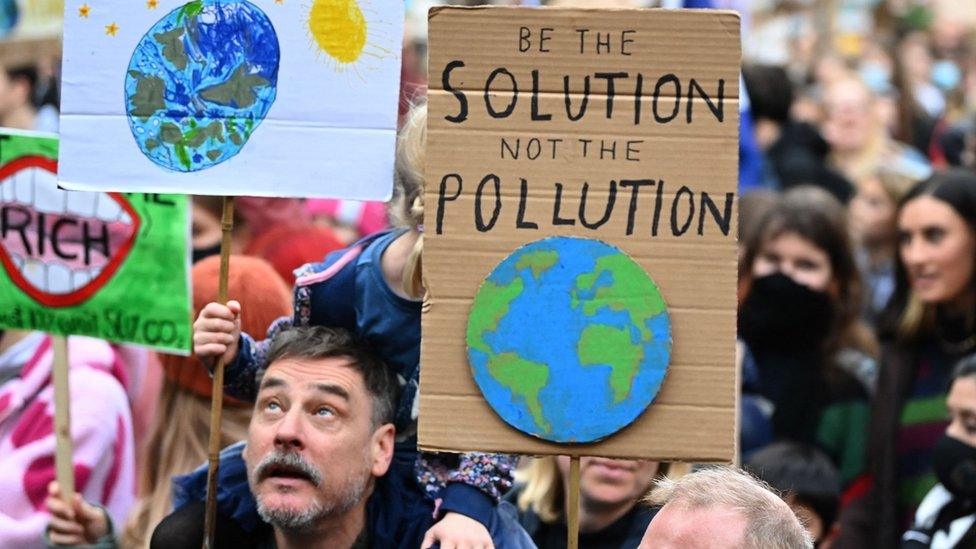Scotland's greenhouse gas emissions fell during Covid pandemic
- Published
- comments

Climate change campaigners say more ambitious action is needed
Scotland's greenhouse gas emissions fell by 12% during 2020 as Covid lockdown restrictions took effect, according to official statistics, external.
International aviation saw the biggest decrease of 67.7% as flights were grounded and holidays cancelled.
Domestic transport remains the biggest source of emissions, followed by business and agriculture.
The drop means the Scottish government met its target to cut adjusted emissions by 56% since 1990.
While the figures published last year showed that the target had been missed in 2019, emissions have now fallen by 58.7% since 1990.
However, environmental groups are concerned that the figures will bounce back in future years.
That concern has been acknowledged by the Scottish government's Net Zero Secretary Michael Matheson, who said there can be "no satisfaction taken" from the drop coming as a result of the pandemic.
These figures are a surprise to nobody, covering a year where much of our economy was shut down and our habits transformed overnight.
It's striking that Scottish ministers are making no real attempt to claim credit for this drop, coming as millions of us faced the misery that came with the pandemic.
Emissions cuts year-on-year have largely been falling but they've been fairly consistently lagging behind the targets until now.
The "green recovery" is meant to use the rebuilding phase of the pandemic to lock in some of the emissions cuts we're reporting today and get Scotland back on track.
But a lot of our old habits have returned, like driving and taking foreign holidays.
They're not back to pre-pandemic levels but sectors like aviation are predicting they will be by next year.
The only category to see a slight increase during 2020 was residential emissions, possibly driven by people working from home - but homes still only accounted for just 15% of the total.
Car emissions were down 26.6% while domestic flights saw a drop of 61.5%.
Although the amount of electricity being generated grew by 4.9%, emissions from that sector fell by 15% because of an increase in renewables from offshore wind.
The five biggest emitting areas were:
Domestic transport - 23.75%
Business - 19.5%
Agriculture - 18.5%
Residential - 15%
Energy generation - 13.25%
Mr Matheson said the most significant changes were in the transport sector, and were associated with the temporary measures taken in response to the Covid pandemic.
"We must be prepared for these figures to substantially rebound in 2021," he said.
"There can be no satisfaction taken in emissions reductions resulting from the health, economic and social harms of the pandemic.
"However, the data does provide a valuable lesson regarding the scale of the transformational change needed."
Vehicle emissions fell during 2020 as restrictions on travel were in place across Scotland
Stop Climate Chaos Scotland (SCCS), a coalition of more than 60 campaigning groups, said the Scottish government needed to "seriously up its game".
"We need to see more ambitious action in all sectors, in particular transport, agriculture and housing," said SCCS chair Mike Robinson.
"Unless enhanced measures are taken to improve delivery, the post-Covid 19 rebound in emissions will ensure that we miss our targets for 2030 and 2045."
Scottish Labour's spokesman Colin Smyth said: "The SNP must not waste the reprieve they've been gifted - we need to build on this progress so that we can meet our targets without the country grinding to a halt."